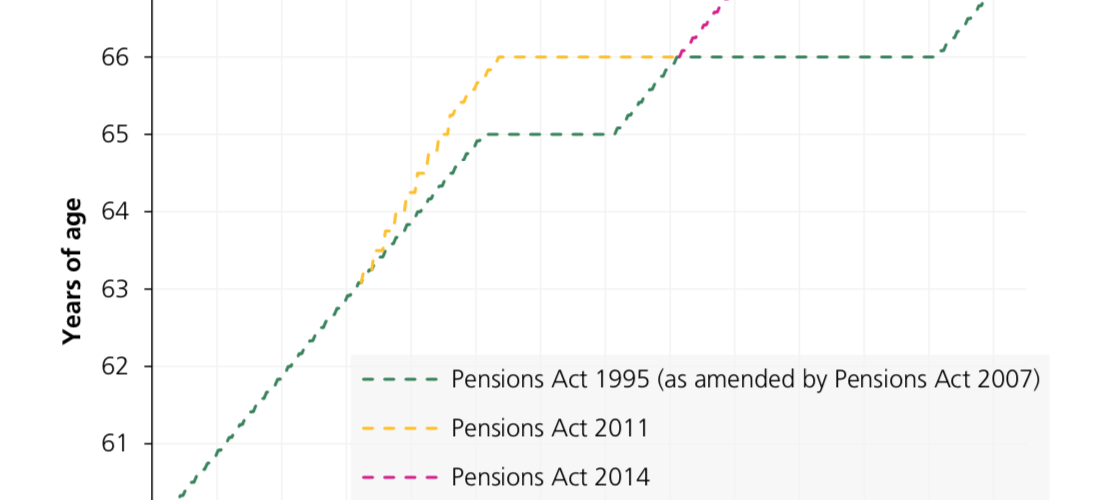
I’m not a WASPI woman. I would be if I’d been born six weeks later than I was. In that case I’d would have had to wait a year for my State Pension. But fortunately for me, the financial year in UK runs from 6 April to 6 April. I know not why but I’m very glad it does.
WASPI stands for Women Against State Pension Inequality. It’s a campaign against the way in which changes to the UK state pension age (SPA) were brought in. The changes are such as to equalise the SPA for wen and women. If the original 1995 Act timetable had been stuck to that would meant a gradual increase in women’s SPA from 60 to 65 from 2010 to 2020. But in 2011 and 2014 further changes were made to accelerate the rate of equalisation and also to raise the SPA for everyone to 66 by 2020 and 67 by 2028.
I have to confess I haven’t really paid much attention to the WASPI campaign apart from feeling some mild sympathy for those affected. I don’t think there is any good argument these days for women receiving their pension before men. And there was 15 years between the new arrangements being agreed and them being implemented which is surely time enough to take on board. Usually ten years is reckoned to be adequate warning fr changes to the law in the UK. However the acceleration brought in by the 2011 Act produced big changes much earlier than ten years.
This is the basis of the WASPI campaign. It’s arguing that
- the rate of change has left some women born in mid 1950s facing a loss of six years pension in a very short period of time
- and that they were not given adequate, or indeed any warning of this.
One of my friends is in this group who are particularly badly effected. Her predicament has made me look for some info about just how the changes are being implemented. Happily the House of Commons Library is a mine of useful information including spreadsheets giving details of just those implementations. When you ask the spreadsheet to show how many women in Scotland are affected and how many years of pension they are foregoing, this is the result.

The total number of women affected in Scotland is 347,000 and overall they are foregoing 1,658,500 pension years. But you can see from the graph that women born from Apr 1954 onwards lose six pension years. Although there is a very big peak in the graph, this covers the four years 1955-59 which is how the data is presented in the official data.
It’s helpful to put the above information together with this from the same source:

That looks simple but it still doesn’t show the change between when we would have received our pension, at 60, and when we’ll get them now. But that information is in the downloadable briefing State Pension Age Increases for Women Born in 1950s. It’s not simple to work out because there are various tranches – some of which cover a full 12 months, some of which are only a few months – when the pensionable age changes. But this is approximately how it works out:

It seems to produce a big shift for those people born in 1953/54. If you are born between Apr1952 and Apr53 you wait an extra three years for your pension. If you are born between Apr-Dec 1953 you have to wait four and a half to five years extra for your pension. And If you are born between Dec1953 and Apr1954 that wait increases to five and a half to six years, by which time the pension age is 66. That’s a big shift for those people and it has come about because of the 2011 Pensions Act which accelerated the rate of increase of SPA and also increased the pensionable age to 66. It is out of this that the WASPI Campaign arose.
There are two Private Members Bills currently before Parliament which are attempting to provide some compensation to the women most affected by these changes. The Bill presented by Welsh Labour MP Carolyn Harris is scheduled to have its second reading at the end of October. It’s purpose is to:
- establish a review of pension arrangements for women affected by changes made by the Pensions Act 1995 and the Pensions Act 2011;
- to require the review in particular to undertake costings for a compensation scheme and consider the operation of section 1(4) of the Pensions Act 2011; and for connected purposes.
The other Bill, presented by Conservative MP Peter Bone, has its second reading scheduled for February next year. More info about these Bills here.
What Can Scotland Do for our WASPI women?
In a nutshell, and with the current constitutional arrangements, we can do nothing. Pensions are an area reserved to Westminster. And Westminster has made it very clear that they don’t feel inclined to help. If we independent of course it would be a vey different matter. Just in case you’ve forgotten these quotes from the top of this post:

Ian Blackford says very clearly that if they had the powers, the SNP would help. There are also significant numbers of MPs from all other parties, including the Conservatives and the DUP, who also want to help. But still the UK Government refuses “renege on their decisions”.
If we were independence, how much would it cost?
SNP estimate is £8billion to reverse the 2011 Act for all WASPI women. 2011 was when the increased speed of change was introduced and the pension age was raised for everyone from 65 to 66. But Guy Opperman, the Pensions Minister, said in 8 Feb 2018 that “The SNP costed this at £8 billion, but that is a vast underestimate: it would actually cost the taxpayer over £30 billion and potentially even more.” (House of Commons, 8 Feb 2018).
Scotland has 9.2% of the UK WASPI women, if it did cost £30billion, Scotland’s share would would £2.76billion. We could do that, maybe not all in one go but we could find that money.





